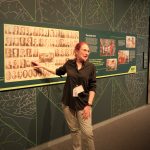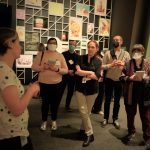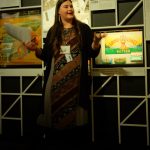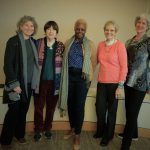By Professor Tiffany Banks On Tuesday, September 30th , students from my COMM 108: Foundations…
March 30th saw us at the National Museum of the American Indian (NMAI) where we spent the afternoon engaging with the landmark exhibit, Americans. Our group was warmly welcomed by Maria Marable-Bunch. Associate Director Museum Learning and Programs, who then turned the afternoon over to Cecile Ganteaume, Curator and Elena Guarinello, Exhibit Developer.
Before actually entering the galleries, Fellows learned about what is involved when a new exhibit is being developed and how curators and designers work together on a vision to achieve a space that will engage visitors, prompt thinking and leave them with something to consider. What kinds of questions should be asked? What should the space look like? How will the exhibit encourage visitors to stay longer than they had expected? What kind of seating should be included? What if someone only visits the main gallery and bypasses the side galleries? How can they ensure that the main gallery contain some of the “big idea takeaways?” They spoke about how they gather information to use in answering these questions, such as formative and summative evaluations of museum visitors and consultation with a variety of units within the museum.

As we stood at the entry to the Americans, we immediately understood how they had translated the goal of reminding us that American Indian images are everywhere in American culture. Images from the sporting world, classic Westerns, children’s toys and games, the space program, on clothing, in street names and signage for all manner of businesses are projected on the walls, grabbing a viewer’s attention. Visitors are confronted by contradictions, from images that highlight, affirm and praise to those that demean and belittle. Each image has its own story, and viewers are encouraged to learn more. Along with brief descriptions identifying each item, an interactive table in the middle of the room allows visitors to learn more about every image and object displayed. The exhibit challenges us to consider the ways in which American Indians have helped form our national identity.

Side galleries allow visitors to more closely examine three particular stories. The first delves into the myth and reality of Pocahontas, the second the Removal Act and Trail of Tears, and the third examines the Battle of Little Bighorn. Fellows considered how Pocahontas’s personal history has become part of the history of the country, one that continues to be reflected in current culture, while also coming to understand that most do not know her real story. At the entry to the Removal Act, the Trail of Tears visitors are met by this message: Trail of Tears. Not what you think. Not Even Close. So much of this story has been left out of standard history books, and visitors are quickly engaged in learning more. The Battle of Little Bighorn poses a seriesof questions such as why have Americans been obsessed with this one loss instead of dozens of victories from the same era? Who really won? This kind of thought-provoking content combined with the objects chosen for display work to prompt conversation. A fourth gallery provides a space for visitors to process, record and submit their initial reactions to all or part of what they have just seen. A number of these comments are on display, and reading through them provides another mechanism for thought about the exhibit as a whole, and each gallery individually.

The afternoon was then turned over to Gabbi Lee, the first native Hawaiian cultural interpreter on the staff at NMAI. She provided each of the Fellows with a dialogue toolkit for educators develop by NMAI and the staff of Native Knowledge360, (NK360) the museum’s educational initiative. The dialogue toolkits developed by NK360 are based in the methodology used by members of the International Coalition of Sites of Conscience (https://www.sitesofconscience.org/). Our handout was specifically geared toward the Americans exhibit, illustrating the phases of dialogue with questions and examples drawn from the galleries we had just toured. Fellows were led through the four phases of the Dialogue process. This hands-on activity demonstrated how Fellows could use this with their own students and was a valuable end to our afternoon.






This Post Has 0 Comments